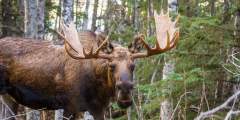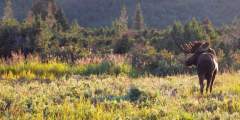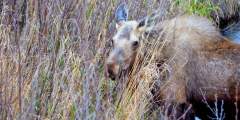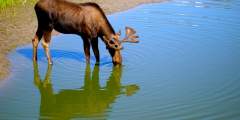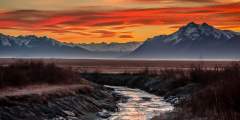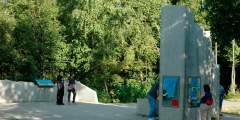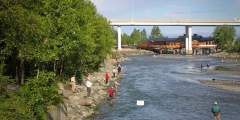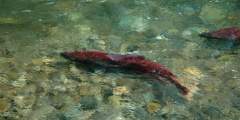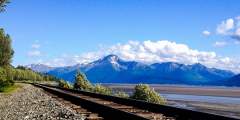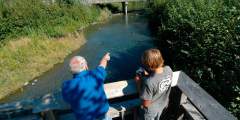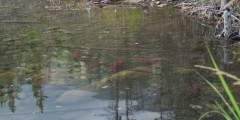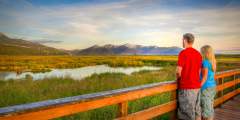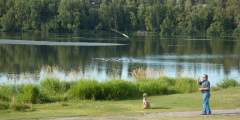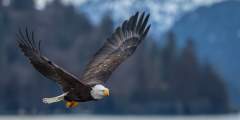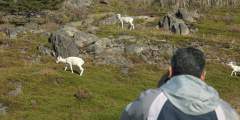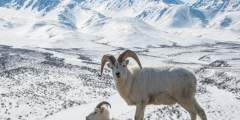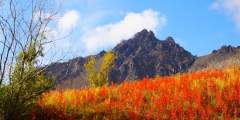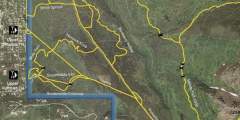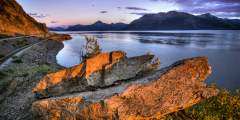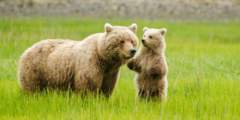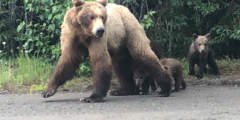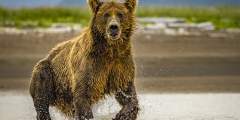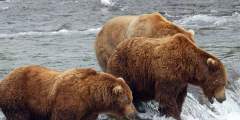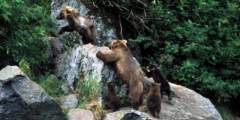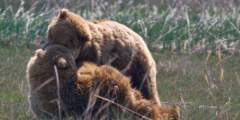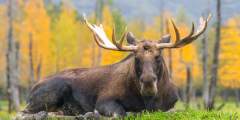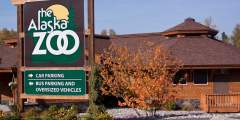The Best Wildlife Viewing Spots in Anchorage
The City of Anchorage may be largest urban area within a thousand miles, but it still supports a full menagerie of its original Alaska wildlife. You might call it a wild city.
Unlike many other populated zones of similar size, the city contains an intact ecosystem with hundreds of wild species thriving in its greenbelts and parks. Biologists say it’s the largest metro area in the world with resident brown bears. Along with this iconic “wilderness” animal, the city is home to hundreds of moose and black bears, not to mention Dall sheep, mountain goats, wolves, wolverines, coyotes, lynx and beavers.
The city hosts one of the largest and most savvy populations of ravens in North America. It’s home to bald eagles and other raptors, nesting loons and swans, epic migratory travelers like Arctic terns and resident songbirds like black-capped chickadees. An endangered population of beluga whales and harbor seals can sometimes be seen just offshore. And wild pacific salmon spawn in most of its creeks.
Try Kincaid Park at the west end of Raspberry Road for your best chance to spy moose, black bears and resident birds. While brown bears are definitely out there, especially along the creek bottoms in Far North Bicentennial Park, you’re probably better off viewing them under safe conditions at the Alaska Zoo and the Alaska Wildlife Conservation Center.
Waterfowl and raptors frequent Potter Marsh in South Anchorage inside the Anchorage Coastal Wildlife Refuge, and is one of the best places in the world to see those stunning black-billed, snow-white trumpeter swans up close. For a glimpse of Cook Inlet’s isolated beluga whales, swing by Beluga Point and Bird Point along the Seward Highway south of town along Turnagain Arm. Along the way, pull safely off the highway at Windy Corner at Mile 106. Then look up. Dall sheep often perch on the cliffs just above the highway.
Show Map
Best Wildlife Viewing Spots in Anchorage
Moosing Viewing Spots
Moose thrive in the open birch-spruce forest and willow thickets of Kincaid Park in the southwestern corner of the Anchorage peninsula. With more than 70 miles of trails crisscrossing its rugged 1,500 acres, Kincaid makes it easy for people to get deep into the woods where moose hang out.
In one of the most extraordinary wildlife spectacles in Alaska, dozens of moose converge on the brushy upper valley of the South Fork of Campbell Creek every fall during moose-mating season. This annual rut in Chugach State Park draws an amazing number of these large animals into the open.
Moose can be spotted frequently in and around Potter Marsh, a 564-acre fresh pond and wetland complex on the outskirts of Anchorage. This rich habitat may be more well-known for migratory and nesting birds, but moose are regular visitors in all seasons.
The Twentymile and Placer river valleys reach for miles into open country visible from the Seward Highway at the head of Turnagain Arm. The five-mile-long valley along Portage Glacier Road — with its many trails, ponds and pullouts — also coaxes moose into the open for reliable viewing.
A great winter viewing opportunity! Moose regularly congregate in this immense, brushy wetland that sprawls at the head of Knik Arm, 30 to 35 miles north of Anchorage. The 28,000-acre refuge has excellent habitat for moose.
This 134-acre park is set in the woods where, in 1964, an entire neighborhood slid into the ocean during last century’s most powerful earthquake. The earthquake was measured at a 9.2 on the Richter scale and lasted 4 minutes. Today, this tragic event is commemorated in Anchorage’s Earthquake Park, where you’ll find signs explaining the circumstances of the quake and its effect on the area.
Salmon Viewing Spots
For glimpses of the big Chinook salmon right inside the city’s industrial heart, check out the hatchery-seeded run at Ship Creek between late May into June. Hatchery-seeded coho salmon begin running through the same waters in late July through August.
If you want to marvel at the sight of thousands of fish schooling in gigantic tanks, take the self-guided tour inside the state fish hatchery on the banks of Ship Creek east of downtown. The museum-quality observation deck offers intimate views of a complex operation that produces up to six million sport fish each year.
Thousands of pink salmon converge on Indian Creek each July and August, just about filling this shallow, easy-flowing stream south of Anchorage along Turnagain Arm from bank-to-bank. This amazing natural spectacle occurs in one of the easiest places to view spawning salmon in the region: No steep banks, crystal clear water and fish so close they could almost be touched.
Crystal-clear Williwaw Creek and its bank-side trail system in Portage Valley at the head of Turnagain Arm offers exceptionally good conditions for watching spawning in action. Coho, sockeye and chum salmon converge on the creek as it winds through the brushy flats beginning in mid-August, with some late-arriving fish still present after first frost in the fall.
Salmon work hard to make their annual appearance at the Eagle River Nature Center’s salmon viewing deck, leaping the abandoned beaver dam, among other obstacles. Over the years, this viewing deck has supported hundreds of photographers capturing moose, bears, eagles, and unparalleled views.
Migratory Birds & Eagles Viewing Spots
Here you’ll find one of the most accessible wildlife viewing areas in Alaska. The marsh is a rest area for migratory birds including trumpeter swans, rednecked grebes, golden eyes, and pintails. Also watch for beavers, moose and bald eagles. You may even spot salmon spawning in the deeper water.
If you’re looking for a wild oasis that’s just a 15-minute walk from downtown Anchorage, look no further than Westchester Lagoon (also known as Margaret Eagan Sullivan Park). One of the city’s most popular places, this is where locals come to play, as it has something for everyone. You’ll find access to great trails and wildlife, as well as year-round activities and events for the entire family.
Bald eagles can be seen from just about any highway pullout and trailhead along Turnagain Arm, a stunning world-class fiord that stretches southeast from Anchorage for almost 50 miles along the Seward Highway.
Sheep Viewing Spots
The premier spot to view wild Dall sheep in Alaska (and maybe the whole continent) looms over one of the state’s busiest highways only 20 miles south of Anchorage.
The 3,000-foot slopes of Penguin Ridge provide habitat for both Dall sheep and mountain goats — one of the few places where the two species overlap.
This trail quickly gains elevation on its way to an alpine meadow framed by the dramatic Twin Peaks and Goat Rock, but climbs to magnificent views overlooking the entire valley. Dall Sheep are often spotted above the timberline. From here there is a spectacular view of the lake below. This is also a good place for berry picking in the fall. Because of the crushed rocks, the trail is hardly ever muddy.
Steep mountain walls, mountain peaks, beautiful valleys and streams, mature Sitka spruce forest, and areas rich in wildlife provide plenty of enjoyment. Dall sheep can sometimes be seen grazing. Use binoculars to scan grassy fingers below ridges across the valley, especially during spring and summer mornings.
Beluga Whale Watching Spots
This is a popular stop as you travel the Seward Highway. Here you’ll find 180 degree views of Turnagain Arm. There’s an extensive viewing area with spotting scopes and interpretive signs. This is an excellent spot to watch the bore tide. The incoming tide stretched the entire width of Turnagain Arm and can be six feet high as it rushes in. Watch for kayakers and surfers riding the wave for several miles. Look for beluga whales rolling in the… ...more
Bear Viewing Tours from AnchorageView All
An easy day trip; pick up and drop-off at your hotel in Anchorage. Lake Clark or Katmai National ParkWith Alaska Air Service you’ll fly from Anchorage to Lake Clark National Park, where they’re a licensed park concessionaire. On the 6- to 7‑hour expedition with an intimate group (there’s a 4‑to‑1 guest-to-guide ratio), you’ll start with a landing inside the park on a beach or in the grasslands to watch bears. Then you’ll travel, unrushed, to other spots in the park. Few operators include multiple locations, but showing you as much of the park’s ...more
Viewing brown bears in their natural habitat is one of the most amazing things you can do in Alaska. If it’s high on your list, book a flight-seeing/ bear viewing trip with Trail Ridge Air, knowing that personable pilots will take you to where bears splash and fish, and where visitors run out of words to describe their amazement.
In the best way possible. you’re outnumbered by bears during your stay at this private fly-in wilderness camp. Fly by chartered plane from Homer to Alaska Bear Camp on a 5‑night, 6‑day all-inclusive package. This deluxe backcountry camp accommodates just 14 guests in some of the best bear habitat in the world. In contrast to day trips catering to dozens of visitors at a time, Bear Camp offers a rare and exclusive wilderness immersion.
Brooks Lodge offers their own bear viewing tours which are less expensive than most, and give you more time at Katmai National Park to watch bears feasting on sockeye salmon from several viewing platforms. A commercial flight from Anchorage takes you to King Salmon where you’ll switch to a small float plane for a quick 20-minute flight to Brooks Camp. After a brief safety orientation, you can watch bears from several viewing platforms, join the ...more
Take off by seaplane for an all-day bear-viewing expedition. Fly past glaciers and volcanoes to the brown-bear country of southwest Alaska. Your Seaplane Bear Safari will take you to Brooks River Falls in Katmai National Park, home of the world ’ s largest salmon run. You can also fly 70 miles southwest of Anchorage to Lake Clark Wilderness Preserve for amazing bear viewing and luxurious accommodations at the Redoubt Bay Lodge. Rust’s, which has ...more
Hop aboard one of Regal Air’s planes departing from Anchorage and after a short, scenic flight you can be watching enormous brown bears swat salmon from Alaska’s rushing waters. Tours visit one of two destinations: Lake Clark National Park or Brooks Falls in Katmai National Park.
Zoos & Conservation Centers
At the 200-acre Alaska Wildlife Conservation Center, see Alaskan wildlife up close. The center’s mission is to provide refuge for orphaned, injured, and ill animals — those that can’t survive in the wild. The center, which opened to the public in 1993, educates visitors about Alaska’s wildlife. Coyotes peer out from behind the brush while a bald eagle swoops in on the salmon remains left by a grizzly bear. Wood Bison plod through 65 acres of tidal ...more
The Alaska Zoo started in 1966 with one baby elephant named Annabelle that was won in a contest. Since then, it has expanded to include over 77 animals across 25 acres of the Anchorage hillside.

